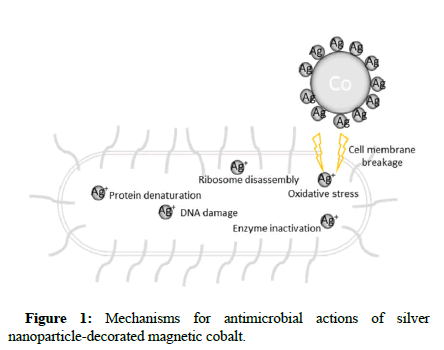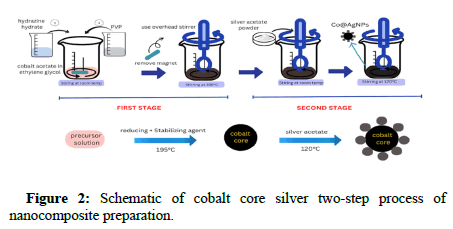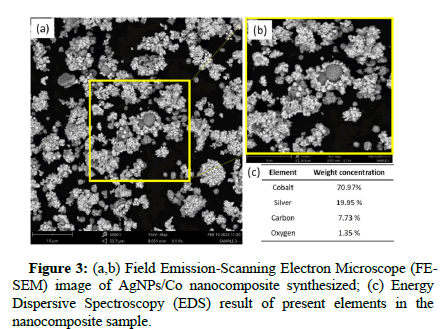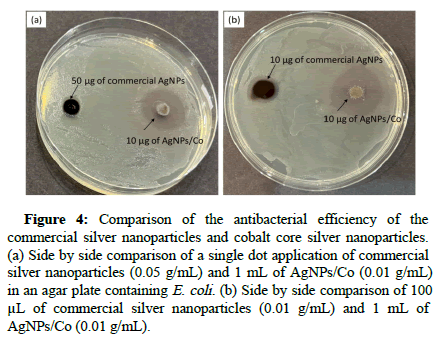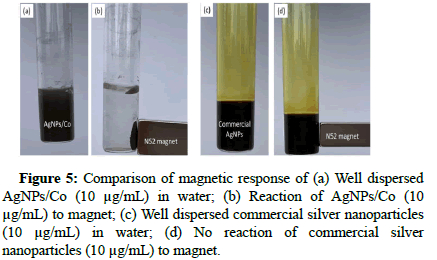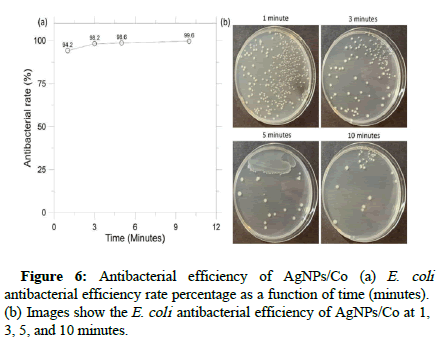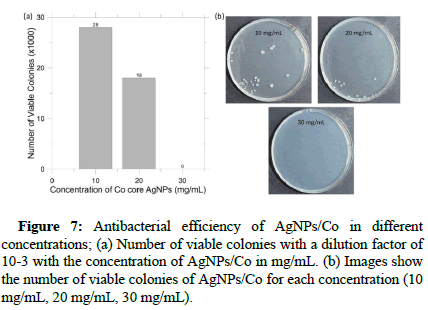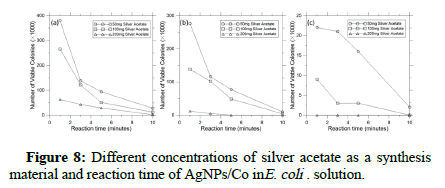Research Article, J Hydrogeol Hydrol Eng Vol: 12 Issue: 6
Effective Disinfection of Escherichia coli Contaminated Water Using Silver Nanoparticle-Decorated Magnetic Cobalt Cores
Jiin Yun1 and Hyukmin Kweon2,3*
1Orange County School of the Arts, Santa Ana, California, United States of America
2Department of Civil and Environmental Engineering, University of California, Los Angeles, California, United States of America
3BenSci Inc., Los Angeles, California, United States of America
*Corresponding Author: Hyukmin Kweon,
Department of Civil and Environmental
Engineering, University of California, Los Angeles, California, United States of
America; BenSci Inc., Los Angeles, California, United State of America
E-mail: kweonhyukmin@gmail.com
Received date: 17 November, 2023, Manuscript No. JHHE-23-120350;
Editor assigned date: 20 November, 2023, PreQC No. JHHE-23-120350 (PQ);
Reviewed date: 04 December, 2023, QC No. JHHE-23-120350;
Revised date: 12 December, 2023, Manuscript No. JHHE-23-120350 (R);
Published date: 21 December, 2023, DOI: 10.4172/2325-9647.1000285
Citation: Yun J, Kweon H (2023) Effective Disinfection of Escherichia coli Contaminated Water Using Silver Nanoparticle-Decorated Magnetic Cobalt Cores. J Hydrogeol Hydrol Eng 12:6.
Abstract
In recent years, the development of silver nanoparticles and their application in wastewater treatment has emerged as a highly effective disinfection method. Wastewater treatment processes effectively remove silver particles and colloids (most processes exceed 95%), but this still leaves notable concentrations escaping to effluent-receiving waters. To address this challenge, in this research, novel magnetic nanocomposites, silver nanoparticle-decorated magnetic cobalt (AgNPs/Co), were studied for disinfection of Escherichia coli (E. coli ) contaminated water. To measure the disinfection efficiency of the AgNPs/Co in the E. coli contaminated water, various studies ranged concentrations from 10 to 50 micrograms. Our results demonstrated an impressive antibacterial efficiency rate of 99.6% when using AgNPs/Co. Additionally, the efficiency rate of collecting the novel magnetic nanocomposites was found to be 100% using a magnet. The AgNPs/Co technology not only exhibits highly efficient water purification capabilities, but it also offers the added benefit of complete removability using a magnet a simple yet effective collection method. This feature plays an essential role in preventing the introduction of toxic silver nanoparticles into reservoirs, which could negatively impact both human populations and ecosystems. By enabling the production of clean water while preserving the environment, this technology stands as an innovative solution for wastewater treatment.
Keywords: Silver nanoparticles; Cobalt cores; Polyol method;
Disinfection; Escherichia coli; Wastewater
Introduction
In the absence of adequate wastewater treatment, there is a persistent risk of diseases such as cholera, typhoid, hepatitis A, and polio spreading [1]. Currently, chlorination, Ultraviolet (UV) radiation, and ozone are the most commonly used disinfection methods for US onsite wastewater treatment systems. However, the repeated use of chlorine has caused an evolution of chlorine-resistant bacteria, which is not properly filtered out before the water is returned to the environment [2]. UV radiation, while effective against specific microorganisms, is limited in its scope. Additionally, ozone treatment fails to target the microorganism’s DNA and arginine, an essential amino acid, which can facilitate horizontal gene transfer, thereby exacerbating public health risk [3]. It is crucial to develop alternative and more efficient methods for wastewater treatment to address these challenges and ensure the protection of public health and the environment.
Silver nanoparticles (AgNPs) are regarded as a highly effective disinfectant in wastewater treatment due to the antibacterial mechanisms of silver ions (Figure 1). The silver ions released from the nanoparticles disturb the permeability of the cell membrane upon attachment to the bacterial wall [4-6]. After entering the cell, the ions 1) bind to sulfhydryl proteins, leading to protein inactivation [7]. 2) Interfere with the respiratory chain, causing oxidative stress [8-10] and 3) disrupt DNA replication, resulting in lipid damage. Eventually, the bacterial wall and membrane will break as a result of cytoplasm leaking, destroying the bacteria. AgNPs inactivate over 99% of Escherichia coli (E. coli ) bacteria after several seconds of contact [11].
The widespread use of AgNPs in commercial and professional applications has resulted in the regular ingestion of residual silver, estimated to be within the range of 20-80 micrograms (μg), through sources such as water contamination, dietary supplements, and food packaging [12,13]. In order to mitigate potential health risks associated with silver exposure, the Environmental Protection Agency limits the daily exposure to silver to 5 μg per kilogram (KG) per day, which is approximately 310 μg for the average human adult weighing 62 kg. AgNPs, upon binding to various human tissues, can elicit toxic effects, including cell activation that leads to the generation of reactive oxygen species, inflammation, and ultimately cell death. Additionally, several reports have documented instances of skin discoloration attributed to the toxicity of AgNPs [14-16]. The absence of effective AgNPs collection not only poses a risk to human health, but also impacts soil communities and aquatic systems [17-21].
Although AgNPs have been proven to be an effective bactericide in water treatment methods, the recollection of leached silver remains a challenge [22]. This research aimed to assess the efficiency of using silver nanoparticles (AgNPs) in the bacterial removal of E. coli from a contaminated water test solution and to explore the potential of using magnets to recollect AgNPs. In order to recollect AgNPs using a magnet, silver nanoparticle-decorated magnetic cobalt (AgNPs/Co), was synthesized by the polyol method, which is a widely-used costeffective and facile soft chemical nanoparticle synthesis method that has been proven to be scalable for industrial application and effective in preparing core-shell nanostructures with tailored size and shapes [23]. This method allowed the fabrication of silver onto the cobalt core medium and control of the nanoparticle size. By giving the nanoparticles a magnetic property, the AgNPs/Co can be recollected using magnets, a quick yet promising method of preventing the silver from leaching into the environment.
Materials and Methods
Materials
All chemicals, including cobalt acetate tetrahydrate, silver acetate, ethylene glycol, Poly-Vinyl-Pyrrolidone (PVP), and hydrazinium hydroxide were purchased from Sigma Aldrich. As reference, commercial silver nanoparticles (50,000 ppm in a 5 mL solution, diameter: 15 nm) (US Research Nanoparticles, US7160) were purchased. Nutrient agar (Innovating Science, IS5350) purchased from Innovating Science was used for the antibacterial tests. E. coli (Carolina Biological, #155065) was purchased from Carolina Biological. An incubator (VEVOR, XHC-25) was purchased from Vevor to let the E. coli cultures grow during the antibacterial tests. Neodymium N52 magnets were used as the recollection material. The N52 magnets were purchased from total element (total element, B1X12X14N52-5PK).
AgNPs/Co synthesis
In this study, a modified polyol process with a transmetalation reduction method was adopted from Kanwal et al., and used to synthesize the desired silver nanoparticle coated cobalt core [24,25]. This method allows fabrication of silver onto the cobalt core medium. Figure 2 shows that the synthesis of nanocomposites was carried out in two stages. First, the cobalt cores were synthesized by dissolving ethylene glycol in a precursor solution of cobalt acetate. Hydrazine hydrate was the reducing agent, and PVP was the stabilizing agent. The reaction was carried out in a hot plate with constant stirring at 200 rpm with a stir bar. A solution of 0.4 milliliter (mL) of hydrazine hydrate and 25 mL of ethylene glycol was added drop wise to the 25 mL precursor solution under constant stirring at room temperature. A 50 mL polymer solution was prepared by dissolving PVP into ethylene glycol. This solution was added and stirred for 15 minutes with an overhead stirrer to prevent the cobalt cores adhering to the magnetic stir bar. The solution was heated to 195°C and the temperature was maintained for 30 minutes. 100 μg of silver acetate was mixed at 200 rpm for 15 minutes. The solution was then heated to 120°C and kept for 15 minutes under continuous stirring. The finalized nanocomposites were collected with magnets and then washed three times to remove impurities. The AgNPs/Cos was precipitated in an aqueous solution until tested.
AgNPs/Co characterization
The AgNPs/Co size was examined with a phenom pharos desktop Field Emission Scanning Electron Microscope (FE-SEM) using a Secondary Electron Detector (SED) from Thermo Scientific (Waltham, MA, USA).
Disinfection tests of E. coli contaminated water
Antibacterial properties were evaluated by the inactivation of bacterial cells on the surface of agar plates via the well diffusion method. To model E. coli contaminated water, E. coli dilutions were created by adding 9 mL of distilled (DI) water (Snugell CPAP distilled water) and 1 mL of E. coli. Further serial dilutions were carried out until a total dilution factor of 10-6 was reached as the synthetic wastewater bacterial concentration.
For each experiment, a concentration of 10 mg of AgNPs/Co was used for the antibacterial activity tests. The commercial silver nanoparticle solution was diluted to match this concentration. For comparison, 0.2 mL of the commercial silver nanoparticles was diluted with 0.8 mL of distilled water for a final concentration of 10 mg. 0.25 mL of E. coli solution was evenly spread with a cell spreader on the top of nutrient agar plates. The petri dishes were kept in an incubator at 37°C for 24 hours.
To find the zone of inhibition, an E. coli solution of 10-3 was spread on the plate. Concentrations of 10,000 μg/mL of both the AgNPs/Co and commercial silver were then added equidistant to each other on the agar plate. The sensitivity of the different concentrations of nanocomposite and the commercial silver nanoparticles to the E. coli were determined by the clear zone around the respective samples and the diameters were measured in millimeters (mm).
To determine the relationship between reaction time, antibacterial efficiency of AgNPs/Co, and E. coli neutralization, further experiments were carried out by manipulating the serial dilutions of the E. coli broth. The experiments involve exposing the E. coli to four different dilutions of the synthesized nanoparticles for varying time intervals (1, 3, 5, and 10 minutes). The reaction time experiments aimed to identify the optimal duration for the nanoparticles to effectively deactivate the E. coli. Additionally, before being dispersed onto nutrient agar-filled plates for further analysis, the E. coli suspension is centrifuged for 5 minutes, which helps separate the bacterial cells from the surrounding medium. To ensure the reliability of the results, all tests were conducted in triplicate, meaning each experiment is repeated three times.
To evaluate the antibacterial efficiency of AgNPs/Co at various concentrations in neutralizing E. coli, the correlation between the concentrations of AgNPs/Co, the deactivation of E. coli, and the concentration of silver acetate used during the nanocomposite synthesis were investigated. Three different concentrations of the AgNPs/Co (10 mg/mL, 20 mg/mL, 30 mg/mL) and three different concentrations of the silver acetate (50 mg, 100 mg, 200 mg) were tested in triplicate.
Results and Discussion
AgNPs/Co characterization
By examining the Field Emission Scanning Electron Microscope (FE-SEM) images (Figure 3), the hypothesis that silver nanoparticles will grow successfully on the surface of cobalt core particles was proven. SEM micrographs show spherical shape and 3-5 mm size range of nanocomposites. This confirms that the first portion of the two-step process creates the cobalt core, and the second portion creates the silver nanoparticle decorations (Figures 3a and 3b).
SEM micrographs showing the spherical morphologies and size range of nanocomposites 3-5 μm Energy Dispersive Spectroscopy (EDS) results show that the mixing ratio of silver and cobalt in the synthesized nanocomposite particles is around 2:8 (Figure 3c).
These findings provide strong evidence for the successful growth of silver nanoparticles on the surface of cobalt core particles, resulting in the formation of spherical nanocomposites with a specific size range and a precise mixing ratio of the two components.
Commercial AgNPs versus AgNPs/Co
The disinfection rate of all synthesized AgNPs/Co and commercial AgNPs against tested microorganisms (E. coli ) was determined using a diffusion method. Figure 4 presents images that present the antibacterial activity of 10 mg/mL and 50 mg/mL of the synthesized AgNPs/Co and commercial AgNPs. Both agar plate samples produced a perimeter of bacterial disinfection; however, the AgNPs/Co had a larger perimeter than the commercial AgNPs. The inhibition zones of the AgNPs/Co were 22 mm and 26 mm for the concentrations 10 mg and 50 mg, respectively. The inhibition zones of the commercial AgNPs were 11 mm and 16 mm for the concentrations 10 mg and 50 mg, respectively.
Figure 4: Comparison of the antibacterial efficiency of the commercial silver nanoparticles and cobalt core silver nanoparticles. (a) Side by side comparison of a single dot application of commercial silver nanoparticles (0.05 g/mL) and 1 mL of AgNPs/Co (0.01 g/mL) in an agar plate containing E. coli. (b) Side by side comparison of 100 μL of commercial silver nanoparticles (0.01 g/mL) and 1 mL of AgNPs/Co (0.01 g/mL).
Magnet efficiency test
To investigate the magnetism of AgNPs/Co, a comparison was made with commercial silver nanoparticles, both dispersed in water at a concentration of 0.01 gram (g)/mL. Figure 5 clearly demonstrates that the AgNPs/Co exhibit a reaction to the magnet, whereas the commercial silver nanoparticles do not. Subsequently, a magnet efficiency test was conducted to determine the nanoparticles' removability by magnets. In this test, 0.2 g of the AgNPs/Co was added to 50 mL of water. After stirring the solution for 3 minutes to ensure full suspension of the nanocomposites, a magnet was employed to collect the AgNPs/Co. These nanocomposites were gathered separately and left for 24 hours to dry. Prior to analysis, the weight of the nanoparticles was measured before and after removal from the aqueous suspension to verify their effective extraction by the magnet.
After leaving the collected nanocomposites to dry for 24 hours, the weight of the nanocomposites remained at 0.02 g. All tests were conducted in triplicate. The AgNPs/Co can be fully collected through magnets, allowing a facile filtration method.
Correlation between reaction time and E. coli cultures
To verify the effectiveness of AgNPs/Co at different concentrations in neutralizing E. coli bacteria, the antibacterial rate was calculated by subtracting the total number of colonies from each sample from the total number of colonies from the control, which was then divided by the total number of colonies from the control.
The antibacterial results signify a strong correlation between the reaction time of the AgNPs/Co and their antibacterial efficiency (Figure 6). The antibacterial rate increases as the reaction time increases. When the AgNPs/Co react with E. coli for 1 minute, 94.2% of the bacteria are killed. When the AgNPs/Co react with E. coli for 10 minutes, the antibacterial rate increases to 99.6%.
Effects of the material concentration
Concentration was manipulated by decreasing the volume of the solution. The first sample, which had an AgNPs/Co concentration of 10 mg/mL, was created by combining 90 mL of DI water and 10 mL of an E. coli solution that was diluted to 10-6. The second sample, with an AgNPs/Co concentration of 20 mg/mL, was created by combining 45 mL of DI water and 5 mL of the same diluted E. coli solution. The third sample, with an AgNPs/Co concentration of 30 mg/mL, was created by combining 30 mL of DI water and 3 mL of the same diluted E. coli solution.
Results show that the concentration of AgNPs/Co plays a strong role in antibacterial efficiency. As the concentration increased, the number of viable E. coli colonies decreased. The increased concentration allows the E. coli to have increased interactions with the AgNPs/Co. The bacteria’s outer membrane interacts with the high surface to volume ratio and small particle size of the AgNPs/Co, which causes a change in the membrane shape and permeability.
As the Co-core membranes cross into the E. coli cell’s membrane, the toxic Co and Ag ions interact with thiol-containing proteins in the cell wall, leading to reactive oxygen species reactions, DNA damage, nucleus breakdown, inhibition of enzyme biosynthesis, and an imbalanced electron transport within the cell.
These reactions can result in the E. coli cell membrane rupturing and ultimate cell destruction. Therefore, as time increases, based on the concentration of the E. coli solution, the AgNPs/Co are able to inactivate a larger number of cells, as seen in Figures 6 and 7.
Concentrations of the silver acetate were manipulated when synthesizing the AgNPs/Co. Three different concentrations (50 mg, 100 mg, 0.200 mg) were tested for each of the three concentrations of AgNPs/Co. Figure 8 clearly shows a correlation between the concentration of silver acetate and the antibacterial efficiency of the nanocomposites. With more added silver acetate, more silver nanocomposites would form around the cobalt core, allowing a greater surface area of the silver and a stronger presence of the silver antibacterial properties.
Conclusions
The usage of AgNPs/Co nanocomposites as a disinfection strategy holds great promise for enhancing wastewater treatment processes, ensuring better removal of microbial contaminants, and reducing the release of AgNPs into the environment. This article offers valuable perspectives that can shape future research and practical applications:
• The successful synthesis of AgNPs/Co nanocomposites using the polyol process was achieved.
• The efficiency of these nanocomposites can be adjusted by controlling reaction time and concentration.
• The study evaluated the magnetic efficiency of the synthesized AgNPs/Co nanocomposite.
• The disinfection efficiency of AgNPs/Co was assessed in E. coli -contaminated water at concentrations ranging from 10 to 50 μg. The results of our research demonstrated an impressive antibacterial efficiency rate of 99.6% when utilizing the AgNPs/Co nanocomposite.
• The novel magnetic nanocomposites exhibited a collecting efficiency rate of 100%, indicating their effectiveness in capturing and removing the AgNPs/Co from the treated water.
• Further research and development in this area may lead to the implementation of efficient and sustainable strategies for water disinfection, benefiting both human health and the ecosystem, and contributing to improved wastewater management.
References
- Ashbolt NJ (2004) Microbial contamination of drinking water and disease outcomes in developing regions. Toxicology 198(1): 229-238.
- Chen L, Wang Z (2018) Effects of chlorination, ultraviolet and ozone disinfection on the biotoxicity of triclosan. Water Supply 19(4): 1175-1180.
- Zheng J, Su C, Zhou J, Xu L, Qian Y, et al. (2017) Effects and mechanisms of ultraviolet, chlorination, and ozone disinfection on antibiotic resistance genes in secondary effluents of municipal wastewater treatment plants. J Chem Eng 317: 309-316.
- Jung WK, Koo HC, Kim KW, Shin S, Kim SH, et al. (2008) Antibacterial activity and mechanism of action of the silver ion in staphylococcus aureus and Escherichia coli. Applied and Environmental Microbiology 74(7): 2171-2178.
- Yin IX, Zhang J, Zhao IS, Mei ML, Li Q, et al. (2020) The antibacterial mechanism of silver nanoparticles and its application in dentistry. IJN 15: 2555-2562.
- Morones JR, Elechiguerra JL, Camacho A, Holt K, Kouri JB, et al. (2005) The bactericidal effect of silver nanoparticles. Nanotechnology 16 (10): 2346-2353.
- Deutscher J, Saier MH (2006) Ser/Thr/Tyr protein phosphorylation in bacteria-for long time neglected, now well established. J Mol Microbiol Biotechnol 9(3-4): 125-131.
- Li WR, Xie XB, Shi QS, Zeng HY, OU-Yang YS, et al. (2010) Antibacterial activity and mechanism of silver nanoparticles on Escherichia coli. Appl Microbiol Biotechnol 85(4): 1115-1122.
- Holt KB, Bard AJ (2005) Interaction of silver(I) ions with the respiratory chain of Escherichia coli: An electrochemical and scanning electrochemical microscopy study of the antimicrobial mechanism of micromolar Ag+. Biochemistry 44 (39): 13214-13223.
- Mates JM (2000) Effects of antioxidant enzymes in the molecular control of reactive oxygen species toxicology. Toxicology 153 (1): 83-104.
- Jones CM, Hoek EMV (2010) A review of the antibacterial effects of silver nanomaterials and potential implications for human health and the environment. J Nanopart Res 12(5): 1531-1551.
- Deshmukh SP, Patil SM, Mullani SB, Delekar SD (2019) Silver nanoparticles as an effective disinfectant: A review. Mater Sci Eng 97: 954-965.
- Matteis VD (2017) Exposure to inorganic nanoparticles: Routes of entry, immune response, biodistribution and in vitro/in vivo toxicity evaluation. Toxics 5(4): 29.
- Kale SK, Parishwad GV, Husainy ASN, Patil AS (2021) Emerging agriculture applications of silver nanoparticles. ES Food Agrofor 3: 17-22.
- Panyala NR, Mendez EMP, Havel J (2008) Silver or silver nanoparticles: A hazardous threat to the environment and human health?. J Appl Biomed 6(3): 117-129.
- Lu W, Senapati D, Wang S, Tovmachenko O, Singh AK, et al. (2010) Effect of surface coating on the toxicity of silver nanomaterials on human skin keratinocytes. Chem Phys Lett 487(1): 92-96.
- Hadrup N, Sharma AK, Loeschner K (2018) Toxicity of silver ions, metallic silver, and silver nanoparticle materials after in vivo dermal and mucosal surface exposure: A review. Regul Toxicol Pharmacol 98: 257-267.
- Levard C, Hotze EM, Lowry GV, Brown GE (2012) Environmental transformations of silver nanoparticles: Impact on stability and toxicity. Environ Sci Technol 46(13): 6900-6914.
- Ferdous Z, Nemmar A (2020) Health impact of silver nanoparticles: A review of the biodistribution and toxicity following various routes of exposure. Int J Mol Sci 21(7):2375.
- Grun AL, Emmerling C (2018) Long-term effects of environmentally relevant concentrations of silver nanoparticles on major soil bacterial phyla of a loamy soil. Environ Sci Eur 30(1): 31.
- Yu S, Yin Y, Liu J (2012) Silver nanoparticles in the environment. Environ Sci: Processes Impacts 15(1): 78-92.
- Fievet F, Merah SA, Brayner R, Chau F, Giraud M, et al. (2018) The polyol process: A unique method for easy access to metal nanoparticles with tailored sizes, shapes and compositions. Chem Soc Rev 47(14): 5187-5233.
- Fiorati A, Bellingeri A, Punta C, Corsi I, Venditti I (2020) Silver nanoparticles for water pollution monitoring and treatments: Ecosafety challenge and cellulose-based hybrids solution. Polymers 12(8): 1635.
- Kanwal Z, Raza MA, Riaz S, Manzoor S, Tayyeb A, et al. (2019) Synthesis and characterization of silver nanoparticle-decorated cobalt nanocomposites (Co@AgNPs) and their density-dependent antibacterial activity. R Soc Open Sci 6(5): 182135.
- Ruz P, Sudarsan V (2021) Polyol method for synthesis of nanomaterials. (1st edn), Indian Institute of Metals Series. Singapore: Springer.
 Spanish
Spanish  Chinese
Chinese  Russian
Russian  German
German  French
French  Japanese
Japanese  Portuguese
Portuguese  Hindi
Hindi 